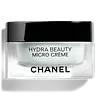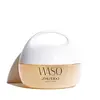What's inside
What's inside
 Key Ingredients
Key Ingredients

 Benefits
Benefits

 Concerns
Concerns

 Ingredients Side-by-side
Ingredients Side-by-side

Water
Skin ConditioningGlycerin
HumectantAlcohol
AntimicrobialPropanediol
SolventButylene Glycol
HumectantIsodecyl Neopentanoate
EmollientIsononyl Isononanoate
EmollientPentylene Glycol
Skin ConditioningIsododecane
EmollientJojoba Esters
EmollientCamellia Japonica Flower Extract
EmollientZingiber Officinale Root Extract
MaskingButyrospermum Parkii Butter
Skin ConditioningMethyl Methacrylate Crosspolymer
Nylon-6
Phenoxyethanol
PreservativeDextrin Palmitate
EmulsifyingNeopentyl Glycol Diheptanoate
EmollientSqualane
EmollientHydrogenated Polydecene
EmollientSodium Acrylates/C10-30 Alkyl Acrylate Crosspolymer
Parfum
MaskingSodium Carbomer
Emulsion StabilisingDipropylene Glycol
HumectantHydroxystearic Acid
CleansingSodium Palmitate
CleansingDisodium EDTA
Amodimethicone
Sodium Citrate
BufferingPalmitic Acid
EmollientSodium Hyaluronate
HumectantT-Butyl Alcohol
PerfumingTocopherol
AntioxidantOctyldodecyl Myristate
EmollientDenatonium Benzoate
MaskingCitric Acid
BufferingCI 42090
Cosmetic ColorantCI 77510
Cosmetic ColorantWater, Glycerin, Alcohol, Propanediol, Butylene Glycol, Isodecyl Neopentanoate, Isononyl Isononanoate, Pentylene Glycol, Isododecane, Jojoba Esters, Camellia Japonica Flower Extract, Zingiber Officinale Root Extract, Butyrospermum Parkii Butter, Methyl Methacrylate Crosspolymer, Nylon-6, Phenoxyethanol, Dextrin Palmitate, Neopentyl Glycol Diheptanoate, Squalane, Hydrogenated Polydecene, Sodium Acrylates/C10-30 Alkyl Acrylate Crosspolymer, Parfum, Sodium Carbomer, Dipropylene Glycol, Hydroxystearic Acid, Sodium Palmitate, Disodium EDTA, Amodimethicone, Sodium Citrate, Palmitic Acid, Sodium Hyaluronate, T-Butyl Alcohol, Tocopherol, Octyldodecyl Myristate, Denatonium Benzoate, Citric Acid, CI 42090, CI 77510
Water
Skin ConditioningGlycerin
HumectantCyclopentasiloxane
EmollientDipropylene Glycol
HumectantXylitol
HumectantAlcohol Denat.
AntimicrobialPEG-20
HumectantBis-PEG-18 Methyl Ether Dimethyl Silane
EmollientDipeptide-15
Skin ConditioningDimethicone
EmollientErythritol
HumectantPEG-150
HumectantPolymethylsilsesquioxane
Trehalose
HumectantSodium Chloride
MaskingBetaine
HumectantPEG-10 Dimethicone
Skin ConditioningPEG/PPG-19/19 Dimethicone
EmulsifyingHydrogenated Polyisobutene
EmollientPhenoxyethanol
PreservativeDimethicone/Vinyl Dimethicone Crosspolymer
Skin ConditioningEthylhexyl Methoxycinnamate
UV AbsorberButylene Glycol
HumectantTrisodium EDTA
PEG/PPG-17/4 Dimethyl Ether
Skin ConditioningCaffeine
Skin ConditioningAlcohol
AntimicrobialCetyl Ethylhexanoate
EmollientParfum
MaskingSodium Metabisulfite
AntioxidantPhytosteryl/Octyldodecyl Lauroyl Glutamate
Skin ConditioningLimonene
PerfumingHexyl Cinnamal
PerfumingPaeonia Albiflora Root Extract
Skin ConditioningButylphenyl Methylpropional
PerfumingBenzyl Benzoate
AntimicrobialLinalool
PerfumingBHT
AntioxidantLamium Album Flower/Leaf/Stem Extract
Skin ConditioningDaucus Carota Sativa Root Protoplasts
EmollientCitrus Junos Seed Extract
AntioxidantTocopherol
AntioxidantBenzoic Acid
MaskingCI 75130
Cosmetic ColorantWater, Glycerin, Cyclopentasiloxane, Dipropylene Glycol, Xylitol, Alcohol Denat., PEG-20, Bis-PEG-18 Methyl Ether Dimethyl Silane, Dipeptide-15, Dimethicone, Erythritol, PEG-150, Polymethylsilsesquioxane, Trehalose, Sodium Chloride, Betaine, PEG-10 Dimethicone, PEG/PPG-19/19 Dimethicone, Hydrogenated Polyisobutene, Phenoxyethanol, Dimethicone/Vinyl Dimethicone Crosspolymer, Ethylhexyl Methoxycinnamate, Butylene Glycol, Trisodium EDTA, PEG/PPG-17/4 Dimethyl Ether, Caffeine, Alcohol, Cetyl Ethylhexanoate, Parfum, Sodium Metabisulfite, Phytosteryl/Octyldodecyl Lauroyl Glutamate, Limonene, Hexyl Cinnamal, Paeonia Albiflora Root Extract, Butylphenyl Methylpropional, Benzyl Benzoate, Linalool, BHT, Lamium Album Flower/Leaf/Stem Extract, Daucus Carota Sativa Root Protoplasts, Citrus Junos Seed Extract, Tocopherol, Benzoic Acid, CI 75130
Ingredients Explained
These ingredients are found in both products.
Ingredients higher up in an ingredient list are typically present in a larger amount.
Alcohol comes in many different forms. Different types of alcohol will have different effects on skin. This ingredient is usually an astringent alcohol.
These alcohols are drying on the skin. They may strip away your skin's natural oils and even damage your skin barrier. Astringent alcohols may also irritate skin.
Other types of astringent alcohols include:
According to the National Rosacea Society based in the US, you should be mindful of products with these alcohols in the top half of ingredients.
Any type of sanitizing product will have high amounts of alcohol to help kill bacteria and viruses.
Fatty alcohols come from plant oils such as coconut oil. These can help hydrate the skin and are non-irritating. Some fatty alcohols include cetyl and stearyl alcohol.
Learn more about AlcoholButylene Glycol (or BG) is used within cosmetic products for a few different reasons:
Overall, Butylene Glycol is a safe and well-rounded ingredient that works well with other ingredients.
Though this ingredient works well with most skin types, some people with sensitive skin may experience a reaction such as allergic rashes, closed comedones, or itchiness.
Learn more about Butylene GlycolDipropylene Glycol is a synthetically created humectant, stabilizer, and solvent.
This ingredient helps:
Dipropylene glycol is technically an alcohol, but it belongs to the glycol family (often considered part of the ‘good’ alcohols). This means it is hydrating and gentle on skin unlike drying solvent alcohols like denatured alcohol.
As a masking agent, Dipropylene Glycol can be used to cover the smell of other ingredients. However, it does not have a scent.
Studies show Dipropylene Glycol is considered safe to use in skincare.
Learn more about Dipropylene GlycolGlycerin is already naturally found in your skin. It helps moisturize and protect your skin.
A study from 2016 found glycerin to be more effective as a humectant than AHAs and hyaluronic acid.
As a humectant, it helps the skin stay hydrated by pulling moisture to your skin. The low molecular weight of glycerin allows it to pull moisture into the deeper layers of your skin.
Hydrated skin improves your skin barrier; Your skin barrier helps protect against irritants and bacteria.
Glycerin has also been found to have antimicrobial and antiviral properties. Due to these properties, glycerin is often used in wound and burn treatments.
In cosmetics, glycerin is usually derived from plants such as soybean or palm. However, it can also be sourced from animals, such as tallow or animal fat.
This ingredient is organic, colorless, odorless, and non-toxic.
Glycerin is the name for this ingredient in American English. British English uses Glycerol/Glycerine.
Learn more about GlycerinParfum is a catch-all term for an ingredient or more that is used to give a scent to products.
Also called "fragrance", this ingredient can be a blend of hundreds of chemicals or plant oils. This means every product with "fragrance" or "parfum" in the ingredients list is a different mixture.
For instance, Habanolide is a proprietary trade name for a specific aroma chemical. When used as a fragrance ingredient in cosmetics, most aroma chemicals fall under the broad labeling category of “FRAGRANCE” or “PARFUM” according to EU and US regulations.
The term 'parfum' or 'fragrance' is not regulated in many countries. In many cases, it is up to the brand to define this term.
For instance, many brands choose to label themselves as "fragrance-free" because they are not using synthetic fragrances. However, their products may still contain ingredients such as essential oils that are considered a fragrance by INCI standards.
One example is Calendula flower extract. Calendula is an essential oil that still imparts a scent or 'fragrance'.
Depending on the blend, the ingredients in the mixture can cause allergies and sensitivities on the skin. Some ingredients that are known EU allergens include linalool and citronellol.
Parfum can also be used to mask or cover an unpleasant scent.
The bottom line is: not all fragrances/parfum/ingredients are created equally. If you are worried about fragrances, we recommend taking a closer look at an ingredient. And of course, we always recommend speaking with a professional.
Learn more about ParfumPhenoxyethanol is a preservative that has germicide, antimicrobial, and aromatic properties. Studies show that phenoxyethanol can prevent microbial growth. By itself, it has a scent that is similar to that of a rose.
It's often used in formulations along with Caprylyl Glycol to preserve the shelf life of products.
Tocopherol (also known as Vitamin E) is a common antioxidant used to help protect the skin from free-radicals and strengthen the skin barrier. It's also fat soluble - this means our skin is great at absorbing it.
Vitamin E also helps keep your natural skin lipids healthy. Your lipid skin barrier naturally consists of lipids, ceramides, and fatty acids. Vitamin E offers extra protection for your skin’s lipid barrier, keeping your skin healthy and nourished.
Another benefit is a bit of UV protection. Vitamin E helps reduce the damage caused by UVB rays. (It should not replace your sunscreen). Combining it with Vitamin C can decrease sunburned cells and hyperpigmentation after UV exposure.
You might have noticed Vitamin E + C often paired together. This is because it is great at stabilizing Vitamin C. Using the two together helps increase the effectiveness of both ingredients.
There are often claims that Vitamin E can reduce/prevent scarring, but these claims haven't been confirmed by scientific research.
Learn more about TocopherolWater. It's the most common cosmetic ingredient of all. You'll usually see it at the top of ingredient lists, meaning that it makes up the largest part of the product.
So why is it so popular? Water most often acts as a solvent - this means that it helps dissolve other ingredients into the formulation.
You'll also recognize water as that liquid we all need to stay alive. If you see this, drink a glass of water. Stay hydrated!
Learn more about Water